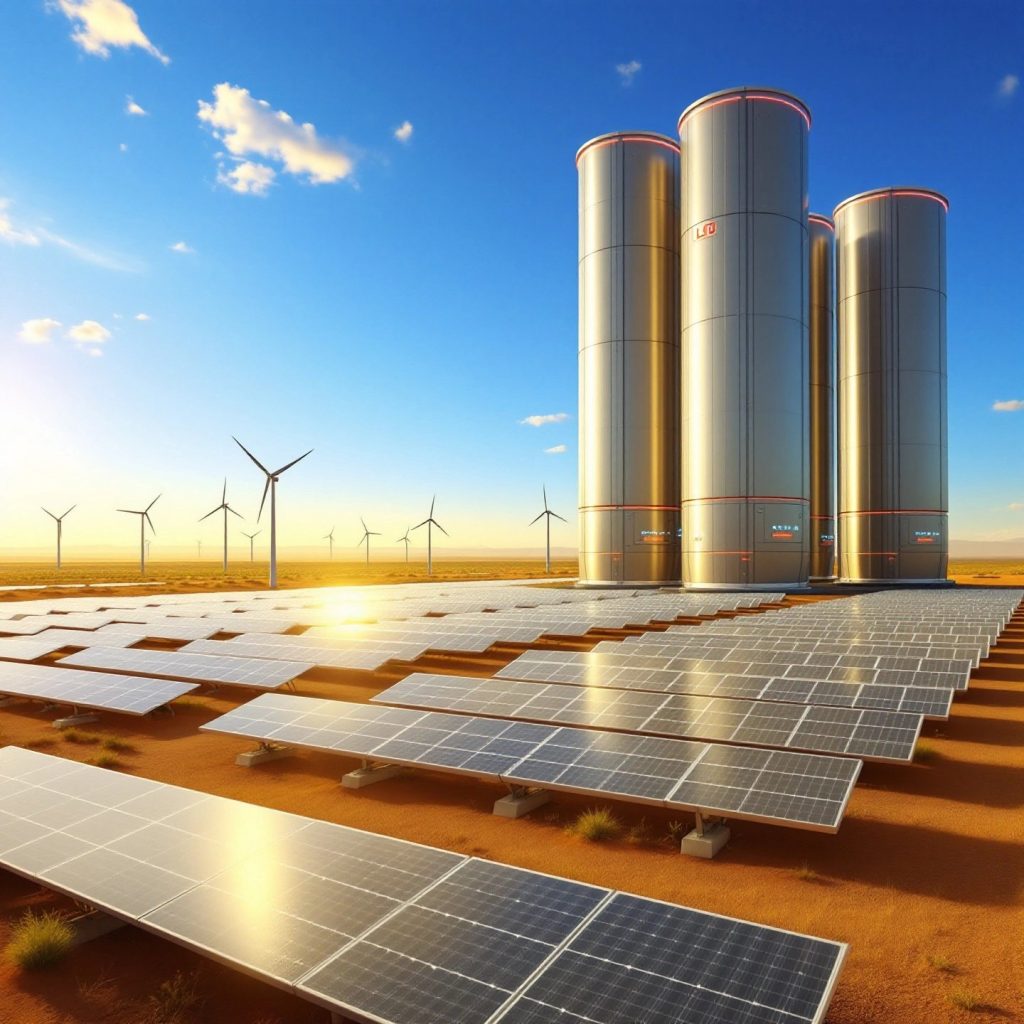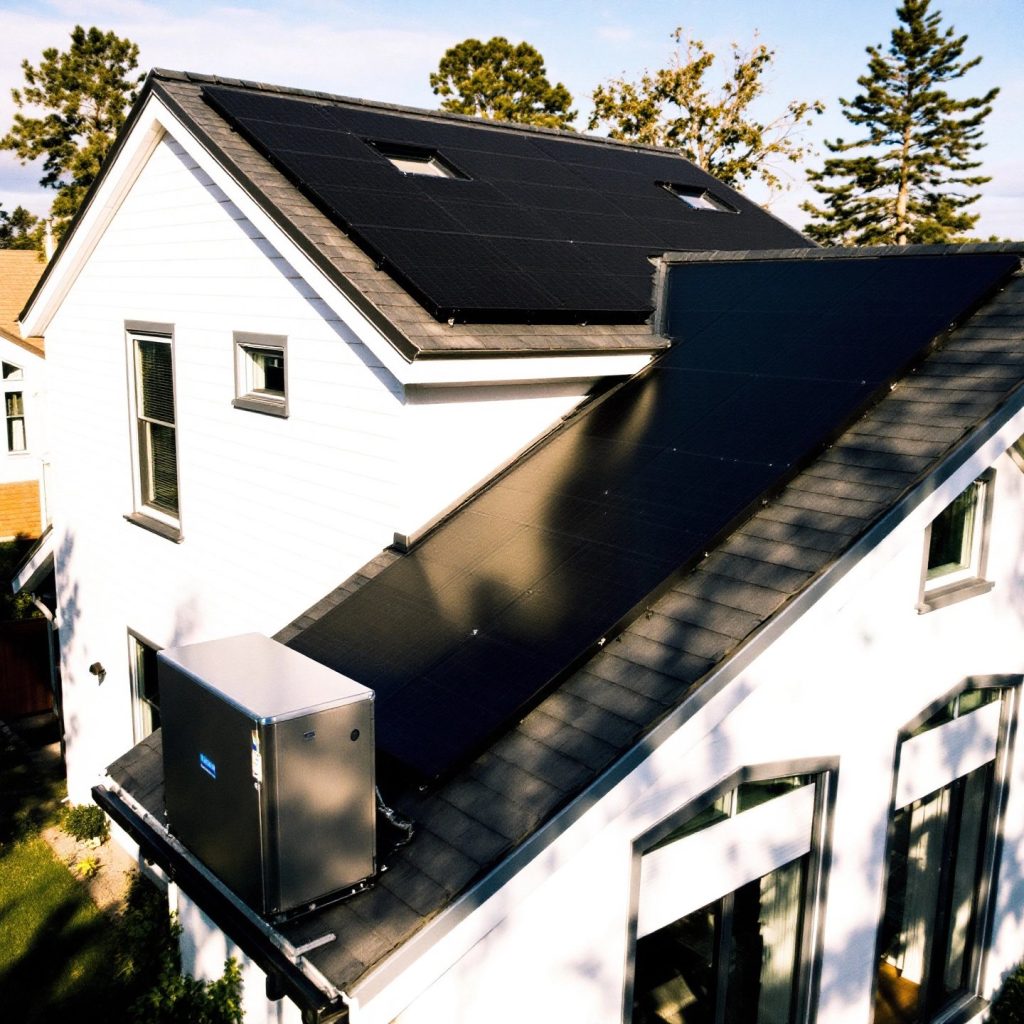Introduction to Thermal Energy Storage
Imagine a world where energy is abundant, yet seamlessly stored and utilized whenever needed. Sounds complex? This vision is becoming a reality through thermal energy storage (TES), a pivotal technology in modern energy systems. At its core, TES involves capturing heat or cold and storing it for later use, optimizing energy consumption and enhancing the reliability of clean power sources.
Thermal energy storage is not just a futuristic concept; it’s a practical solution addressing the intermittency of renewable energy sources like solar and wind. When the sun isn’t shining or the wind isn’t blowing, TES ensures that the energy harnessed during peak times is available when demand is high. This capability is crucial for maintaining grid stability and enhancing the efficiency of energy systems.
Incorporating TES into energy infrastructures offers several advantages. First, it significantly reduces energy costs by shifting energy use from peak to off-peak periods, when electricity is cheaper and more abundant. This not only saves money but also reduces the strain on the grid during high-demand periods. Furthermore, TES contributes to a sustainable future by lowering carbon emissions. By optimizing the use of renewable energy, TES helps decrease dependence on fossil fuels, aligning with global decarbonization goals.
In essence, thermal energy storage is more than just an energy-saving tool; it’s a cornerstone of sustainable energy strategies. As we move towards a clean power future, TES will play an increasingly vital role in balancing energy supply and demand, ensuring that renewable energy can meet our needs effectively and efficiently. With continued advancements, TES holds the promise of transforming how we generate, store, and use energy, paving the way for a greener, more resilient world.
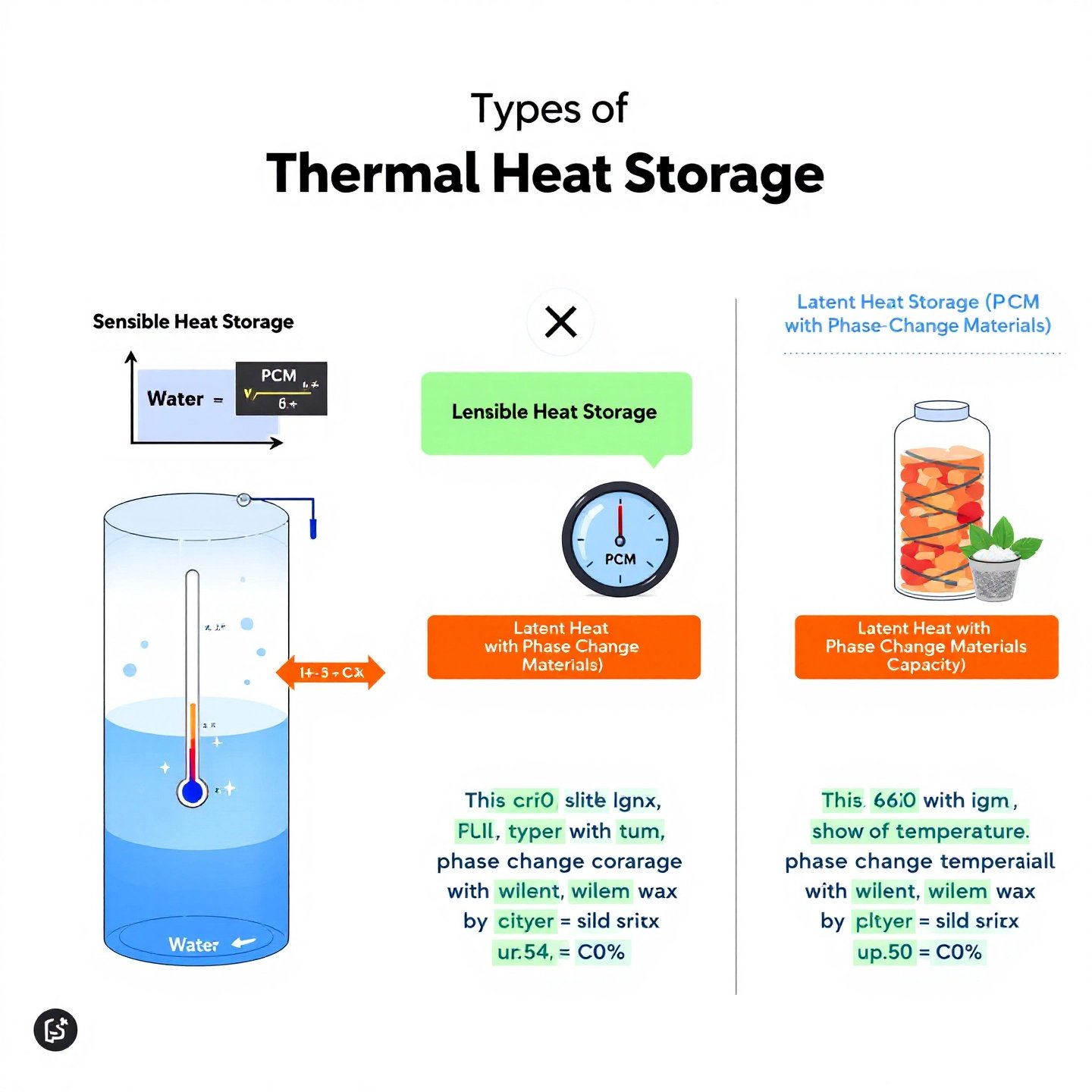
Understanding the Fundamentals of Thermal Energy Storage
At its essence, thermal energy storage (TES) is about capturing thermal energy for use at a later time, much like a battery stores electrical energy. But what is thermal energy storage, and how does it function? TES systems operate by absorbing heat or cold during periods of low demand and releasing it when the demand peaks. This process not only optimizes energy efficiency but also enhances the stability of energy systems, particularly those reliant on renewable sources.
Types of Thermal Energy Storage Systems
TES can be categorized into three primary types: sensible heat storage, latent heat storage, and thermochemical storage. Each of these systems has unique characteristics and applications:
- Sensible Heat Storage: This method involves storing thermal energy by raising the temperature of a solid or liquid without changing its phase. Common materials used include water, sand, or rocks. It’s a straightforward approach, but the energy density is relatively low compared to other methods.
- Latent Heat Storage: This technique leverages phase change materials (PCMs) to store energy. When a PCM changes state, such as melting or solidifying, it absorbs or releases a significant amount of energy at a constant temperature. This makes latent heat storage particularly efficient for applications requiring temperature regulation.
- Thermochemical Storage: This advanced method involves reversible chemical reactions to store and release energy. Materials like zeolites or salt hydrates are often used, offering high energy density and the potential for long-term storage without significant losses. According to Wikipedia, thermochemical storage can achieve higher capacities than other TES methods.
Benefits of Thermal Energy Storage Systems
Implementing TES systems offers several advantages, particularly in the realm of load balancing and efficiency. By storing excess energy during periods of low demand and releasing it during peak times, TES systems help stabilize power grids and reduce reliance on fossil fuels. This not only leads to cost savings but also supports sustainability goals by minimizing carbon emissions.
Moreover, TES systems can enhance the performance of heating and cooling systems in buildings. By providing a stable thermal source, they improve the efficiency of heat pumps and reduce energy consumption. As noted by the U.S. Department of Energy, TES systems play a crucial role in making buildings more resilient and energy-efficient.
In summary, thermal energy storage systems are integral to modern energy strategies, offering a reliable means to manage energy supply and demand effectively. As technology advances, TES will continue to be a key player in the transition to a more sustainable and efficient energy future.
Essential System Components and Design Factors
When considering thermal energy storage, the design and construction of thermal energy storage tanks are pivotal. These tanks act as the backbone of the system, storing heat or cold efficiently until it is needed. But what makes a thermal energy storage tank effective? Let’s dive into the design considerations and materials that optimize their performance.
Design Considerations for Thermal Energy Storage Tanks
Thermal energy storage tanks are typically constructed using materials like reinforced concrete, stainless steel, or plastic. Each material offers unique benefits. For instance, reinforced concrete is robust and cost-effective, while stainless steel provides excellent corrosion resistance and durability. The choice of material often depends on the specific application and environmental conditions.
Insulation is another critical factor in tank design. Extruded polystyrene (XPS) is commonly used to prevent heat loss, while a layer of PVC can protect the insulation from moisture, especially in underground installations. This combination ensures that the system remains efficient by minimizing thermal losses.
Comparative Analysis of Materials and Insulation
| Material | Advantages | Disadvantages |
|---|---|---|
| Reinforced Concrete | Cost-effective, robust | High thermal loss, complex construction |
| Stainless Steel | Corrosion-resistant, durable | Expensive, potential for leakage |
| Plastic | Lightweight, versatile | Less durable, lower temperature range |
Thermal stratification is a natural phenomenon within these tanks, where hot water rises to the top and cold water settles at the bottom. This stratification is beneficial as it reduces mixing and heat loss, enhancing the efficiency of the storage system. To maximize stratification, designs often incorporate diffusers and baffles, although these can increase complexity and cost.
Integration and Best Practices
For seamless integration, it’s essential to consider the entire thermal energy storage system, including the tank, heat exchangers, and control systems. The Trane thermal battery energy storage system, for example, exemplifies best practices by integrating advanced controls that optimize charging and discharging cycles, ensuring maximum efficiency and reliability.
In conclusion, the design of thermal energy storage tanks is a sophisticated process that balances material choice, insulation, and system integration to achieve optimal performance. As we continue to innovate, these systems will play an increasingly vital role in sustainable energy solutions, paving the way for a cleaner, more efficient future.
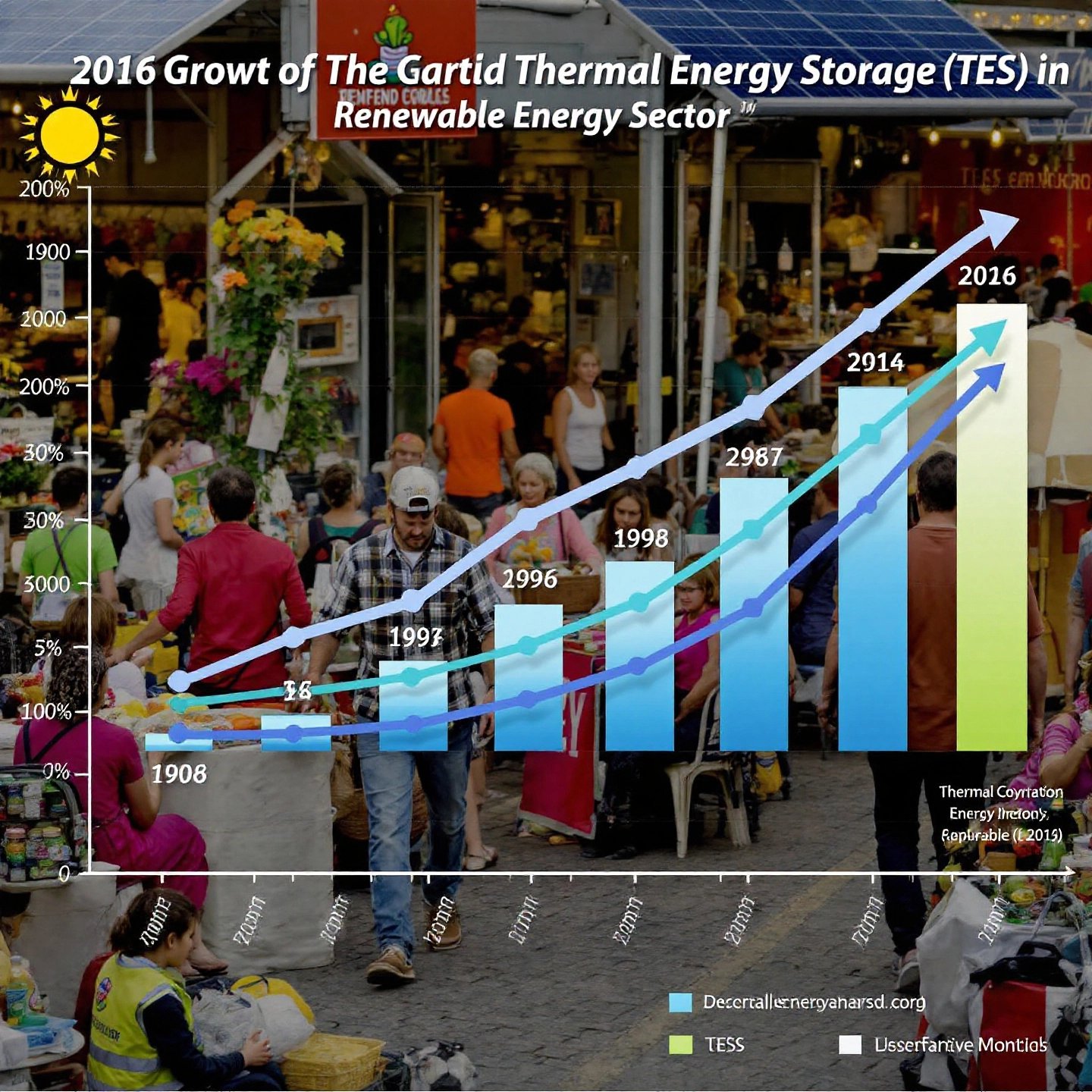
Market Perspectives and Research Highlights
In recent years, the thermal energy storage market has witnessed significant growth, driven by the global push towards sustainable energy solutions and the increasing need for efficient energy management systems. But what exactly is fueling this expansion, and what are the key benefits of thermal energy storage?
Current Market Trends
The thermal energy storage market is projected to grow substantially, with the Americas expected to experience the highest compound annual growth rate (CAGR) during the forecast period. This growth is largely attributed to the rising demand for renewable energy and the decentralization of energy systems. According to MarketsandMarkets, the latent heat storage segment is anticipated to grow at the highest CAGR, driven by advancements in phase change materials (PCMs) and their applications in various industries.
One of the primary drivers of this market is the increasing adoption of thermal energy storage in district heating and cooling applications. This application segment has captured the largest share of the market due to its ability to enhance energy efficiency and reduce operational costs in urban areas. Additionally, the use of molten salts in concentrated solar power (CSP) plants is becoming more prevalent, offering a reliable solution for large-scale energy storage.
Benefits of Thermal Energy Storage
Thermal energy storage offers numerous benefits, particularly in improving the efficiency and reliability of energy systems. By storing excess energy generated during low-demand periods and releasing it during peak demand, TES systems help stabilize the grid and reduce the reliance on fossil fuels. This not only results in cost savings but also supports environmental sustainability by lowering carbon emissions.
Moreover, TES systems are essential in integrating renewable energy sources into the grid. They provide a buffer that mitigates the intermittency of solar and wind power, ensuring a consistent energy supply. This capability is crucial for achieving global net-zero targets and transitioning to a circular economy.
Research and Innovation
Innovation in thermal energy storage technology continues to evolve, with ongoing research focusing on enhancing efficiency and reducing costs. The development of advanced materials, such as high-performance PCMs and thermochemical storage solutions, is paving the way for more effective energy storage systems. Furthermore, the patent landscape in the TES industry is expanding, with key players investing in research and development to gain a competitive edge.
For those interested in exploring the latest innovations and insights in thermal energy storage, Renewable Energy Nexus offers a wealth of resources and expert guidance on sustainable power solutions.
In summary, the thermal energy storage market is poised for significant growth, driven by technological advancements and the global shift towards renewable energy. As the market expands, TES systems will play a critical role in achieving sustainable energy goals and enhancing the resilience of power systems worldwide.
Phase Change Materials and Solar Integration
When you think of energy storage, batteries might be the first thing that comes to mind. However, phase change materials (PCMs) offer a fascinating alternative for thermal energy storage, particularly when integrated with solar systems. But how do these materials work, and what makes them so effective?
How Phase Change Materials Work
Phase change materials store and release thermal energy during the process of melting and solidifying. Imagine a material that absorbs heat as it melts and releases that heat as it solidifies. This process allows PCMs to store large amounts of energy in a relatively small volume, making them ideal for space-constrained applications. According to a study by Prieto and Cabeza, PCMs can significantly enhance the efficiency of solar thermal energy storage systems by leveraging their high latent heat capacity (ScienceDirect).
Integration with Solar Systems
Integrating PCMs with solar thermal systems is a game-changer for renewable energy. Concentrated Solar Power (CSP) plants, which use mirrors or lenses to focus sunlight, can benefit immensely from PCMs. These materials provide a buffer that stores excess heat generated during peak sunlight hours, which can then be used to generate electricity when sunlight is not available. This ensures a continuous power supply, enhancing the reliability of solar energy systems.
Furthermore, PCMs are particularly effective in CSP plants due to their ability to maintain a stable temperature during the phase change, which is crucial for the efficient operation of these systems. As noted by HeliosCSP, this integration not only improves energy efficiency but also helps in reducing the overall cost of energy production.
Environmental and Economic Impacts
The combination of solar power with thermal storage using PCMs has significant environmental and economic benefits. By reducing the need for fossil fuels, this integration helps lower carbon emissions, contributing to global sustainability goals. Economically, it reduces the cost of energy production by optimizing the use of available solar energy, minimizing the need for alternative energy sources during peak demand.
In conclusion, phase change materials for thermal energy storage are transforming the landscape of renewable energy. Their integration with solar systems not only enhances energy efficiency and reliability but also supports environmental sustainability and economic viability. As we continue to innovate, the role of PCMs in solar thermal energy storage will undoubtedly expand, paving the way for a cleaner, more sustainable energy future.
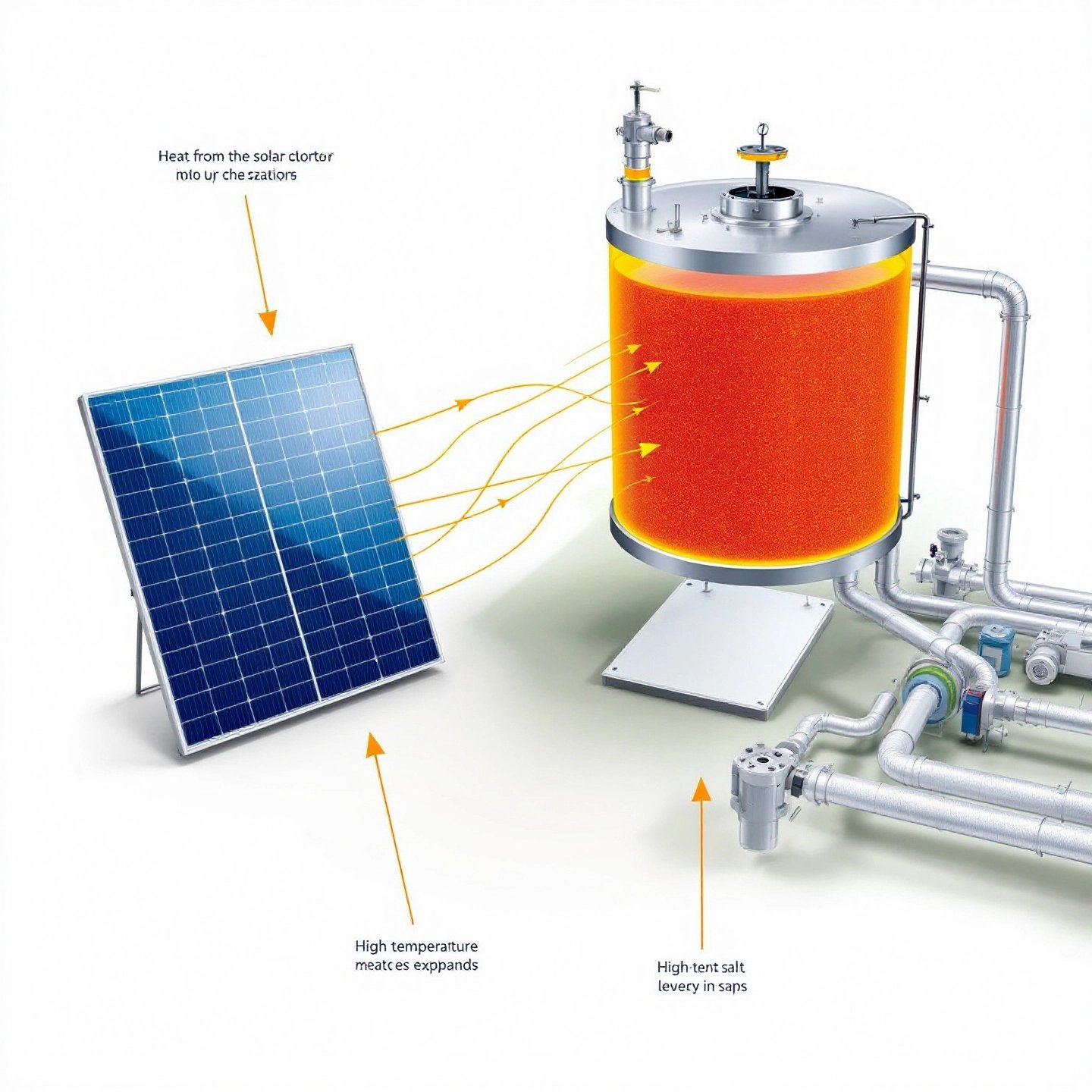
Innovative Molten Salt Solutions for Heat Retention
When you think of thermal energy storage, molten salt might not be the first thing that comes to mind. Yet, it plays a pivotal role in large-scale applications, particularly in concentrated solar power (CSP) plants. But what makes molten salt thermal energy storage so effective?
How Molten Salt Thermal Energy Storage Works
Molten salt thermal energy storage functions by utilizing a mixture of sodium and potassium nitrate salts, which are heated to a molten state. This mixture can store thermal energy at high temperatures, typically between 290°C and 565°C, and retain it with minimal loss. Imagine a giant thermos that can hold heat for hours or even days. When energy demand peaks, the stored heat is used to generate steam, driving turbines to produce electricity.
One of the key advantages of molten salt is its ability to store and release energy efficiently, making it ideal for CSP plants that need to generate electricity even when the sun isn’t shining. The heat retention capabilities of molten salt systems ensure that power generation can continue seamlessly, enhancing the reliability and stability of renewable energy sources.
Breakthroughs and Commercial Projects
The global interest in molten salt thermal energy storage has led to several groundbreaking projects. For instance, the DEWA CSP project in Dubai, UAE, is a prime example of molten salt’s potential. This massive 700 MW project, as reported by SolarPACES, involves melting 340,000 tons of salt to store solar energy, supporting Dubai’s clean energy strategy. Such projects not only showcase the feasibility of molten salt storage but also set new benchmarks for cost-effective renewable energy solutions.
Moreover, technological advancements continue to improve the efficiency and cost-effectiveness of molten salt systems. Innovations in material science are enhancing the thermal stability and lifespan of these systems, making them more viable for widespread adoption. The DEWA project, for instance, demonstrates how strategic partnerships and technological innovations can lead to record-breaking achievements in renewable energy.
Future Prospects
As the demand for clean, reliable energy grows, the role of molten salt thermal energy storage is set to expand. Its integration into CSP plants not only supports grid stability but also aligns with global decarbonization goals by reducing reliance on fossil fuels. Imagine a future where cities are powered by the sun, even after sunset, thanks to the heat retained in molten salt.
In conclusion, molten salt thermal energy storage is more than just a technological marvel; it’s a cornerstone of sustainable energy solutions. As we continue to innovate and invest in this technology, its potential to transform the energy landscape becomes increasingly apparent. With projects like DEWA leading the way, molten salt storage is poised to play a crucial role in the transition to a cleaner, more resilient energy future.
Cooling Strategies for Residential and Commercial Settings
When you think of cooling your home or office, traditional air conditioning systems might come to mind. However, innovative approaches like ice thermal energy storage and chilled water systems are transforming how we manage temperature, offering efficient solutions for both residential and commercial settings. But how do these systems work, and what makes them so effective?
Ice Thermal Energy Storage
Ice thermal energy storage is a method that shifts energy consumption from peak to off-peak hours, significantly reducing operational costs and energy demand. During the night, when energy is cheaper, water is chilled and frozen into ice using a glycol solution. This ice is then stored in tanks and used the next day to cool buildings during peak hours, minimizing the need for traditional air conditioning systems. According to CALMAC, this approach not only saves money but also reduces the environmental impact of cooling systems by lowering energy consumption and emissions.
Chilled Water Thermal Energy Storage
Chilled water storage operates on a similar principle but uses chilled water instead of ice. Water is cooled during off-peak times and stored in large insulated tanks. During peak demand, this chilled water is circulated through the building’s HVAC system, providing cooling without the need for additional energy consumption. This strategy is particularly effective in large commercial buildings where cooling demands are high and consistent.
Optimizing HVAC Systems
Both ice and chilled water thermal energy storage systems play a crucial role in optimizing HVAC operations. By shifting energy usage to off-peak times, these systems help reduce the load on electrical grids and lower energy costs. Furthermore, they enhance the efficiency of HVAC systems by providing a steady and reliable cooling source, which is especially beneficial in climates with extreme temperatures.
For those looking to integrate renewable energy solutions into their cooling strategies, Renewable Energy Nexus offers a range of solar panels that can complement these thermal storage systems. By harnessing solar energy, you can further decrease your reliance on traditional power sources, achieving a more sustainable and cost-effective cooling solution.
In conclusion, ice and chilled water thermal energy storage systems provide innovative and efficient cooling solutions for both residential and commercial applications. By optimizing energy use and integrating renewable resources, these systems not only reduce costs but also contribute to a more sustainable and environmentally friendly energy landscape.
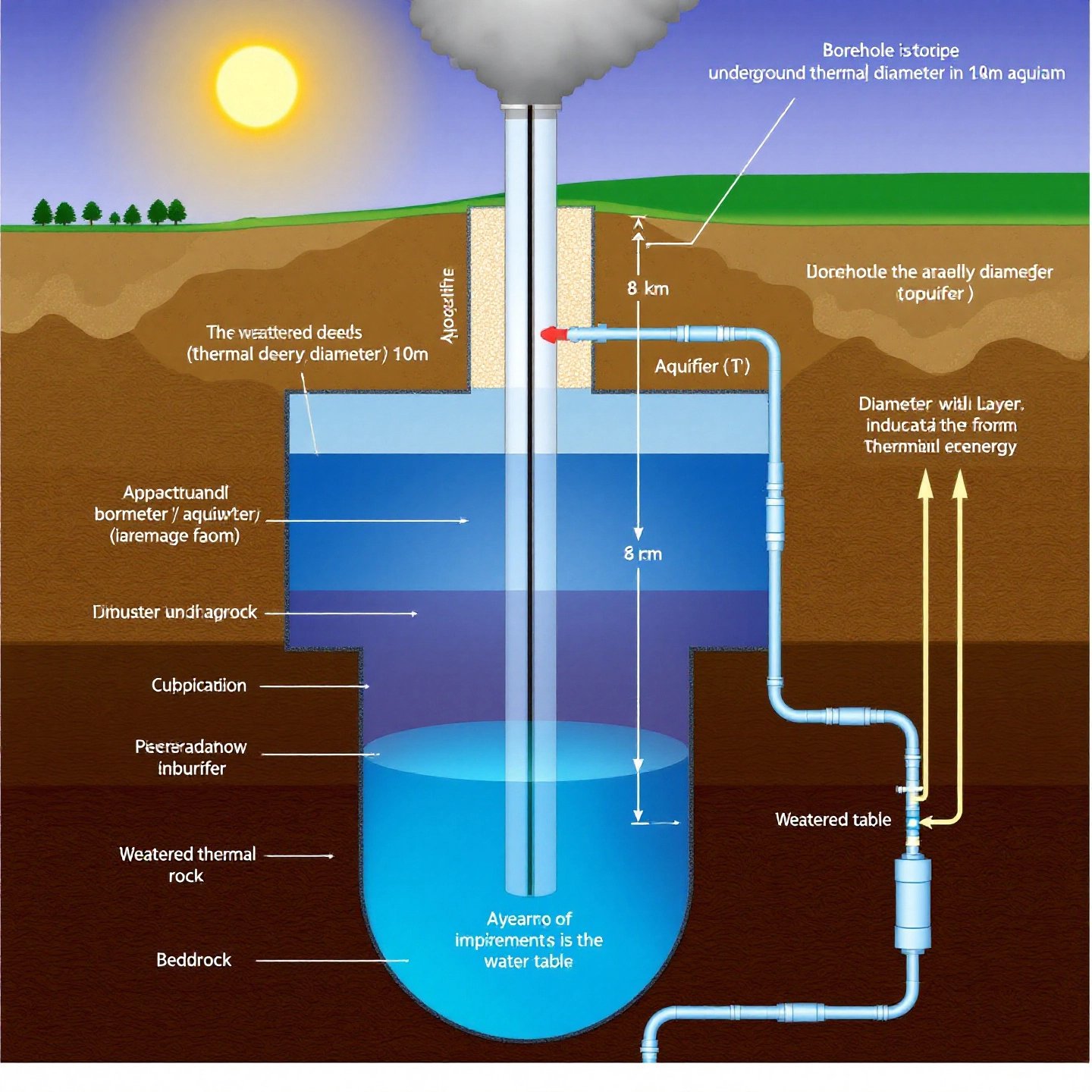
The Potential of Underground and Aquifer Storage
Imagine a storage system that utilizes the earth’s natural properties to efficiently store thermal energy. This is the essence of borehole and aquifer thermal energy storage systems, which leverage underground formations to store heat or cold for later use. But how do these systems work, and what makes them feasible?
Borehole Thermal Energy Storage (BTES)
Borehole thermal energy storage (BTES) involves drilling deep holes into the ground, typically ranging from 30 to 200 meters in depth, and using these boreholes to store thermal energy. The ground itself acts as the storage medium, with heat exchangers inserted into the boreholes to facilitate the transfer of heat. This system is particularly effective for seasonal energy storage, where excess heat collected during the summer can be stored and used during the winter months.
- **Geological Requirements:** BTES systems are best suited for regions with stable geological formations, such as solid rock or water-saturated sands, which offer high thermal conductivity and capacity.
- **Feasibility Factors:**
- Ground thermal conductivity and capacity
- Depth and spacing of boreholes
- Cost of drilling and installation
- Environmental regulations and impact assessments
For instance, the Drake Landing Solar Community in Canada uses BTES to achieve a solar fraction of over 90%, demonstrating the system’s effectiveness in large-scale applications (ScienceDirect).
Aquifer Thermal Energy Storage (ATES)
Aquifer thermal energy storage (ATES) utilizes natural underground water reservoirs to store and retrieve thermal energy. Wells are used to inject and extract water, which acts as the thermal storage medium. This method is particularly advantageous in areas with high groundwater availability and suitable hydrogeological conditions.
- **Geographical Requirements:** ATES systems require aquifers with sufficient permeability and porosity to allow efficient water movement and heat transfer.
- **Feasibility Factors:**
- Aquifer depth and water quality
- Hydraulic conductivity and storage coefficient
- Potential for thermal pollution and environmental impact
- Regulatory compliance and water rights
ATES systems are increasingly used in district heating and cooling applications, offering significant energy savings and reduced carbon emissions (ScienceDirect).
In conclusion, both borehole and aquifer thermal energy storage systems present viable solutions for sustainable energy management. By utilizing the earth’s natural properties, these systems provide efficient and cost-effective means of storing thermal energy, paving the way for a more resilient and environmentally friendly energy future.
Future Outlook and Emerging Trends in Thermal Energy Storage
Imagine a future where energy is not only sustainable but also seamlessly integrated into our daily lives. This vision is increasingly achievable thanks to advancements in thermal energy storage (TES) materials and evolving policy frameworks. But what does the future hold for TES, and how can we capitalize on its advantages?
Advancements in TES Materials
Recent innovations in TES materials are paving the way for more efficient energy storage solutions. Advanced materials, such as high-performance phase change materials (PCMs) and thermochemical storage solutions, are being developed to enhance energy density and thermal conductivity. According to Climafix, these materials are crucial for optimizing the storage and release of thermal energy, reducing reliance on fossil fuels, and mitigating carbon emissions.
Furthermore, nano-enhanced TES materials are emerging as a promising area of research. The integration of nanomaterials, such as nanoparticles and nanofluids, can significantly improve the thermal properties of TES systems, making them more efficient and cost-effective. This innovation not only supports the integration of renewable energy sources but also enhances the overall performance of energy systems.
Policy Shifts and Infrastructure Growth
Policy frameworks play a pivotal role in shaping the future of TES. Governments worldwide are recognizing the importance of energy storage in achieving sustainability goals, leading to increased funding for research and development. Policies promoting standardization and interoperability are essential for reducing deployment costs and facilitating the widespread adoption of new technologies.
Additionally, infrastructure growth is crucial for expanding the advantages of thermal energy storage. Investment in grid modernization and renewable energy integration will enhance the resilience and reliability of power systems. The development of smart grids, for instance, allows for more efficient energy distribution and management, ensuring that TES systems can operate at their full potential.
Moreover, international agreements and collaborations are driving the global adoption of TES technologies. By aligning policies with international sustainability goals, countries can foster innovation and create a cohesive framework for energy transition. This collaborative approach not only accelerates technological advancements but also ensures that the benefits of TES are maximized on a global scale.
Expanding the Advantages of TES
The future of thermal energy storage is promising, with the potential to revolutionize how we generate, store, and use energy. By harnessing advanced materials and supportive policies, TES can significantly enhance energy efficiency and reliability. As infrastructure grows and regulatory support strengthens, the advantages of TES will continue to expand, paving the way for a more sustainable and resilient energy future.
In conclusion, the trajectory of thermal energy storage is set for remarkable growth. By focusing on material innovations and policy advancements, we can unlock the full potential of TES. Imagine a world where energy is clean, reliable, and accessible to all—thermal energy storage is key to making this vision a reality.
Conclusion
As we reflect on the transformative potential of thermal energy storage (TES), it’s clear that this technology is a cornerstone of our sustainable energy future. Imagine a world where energy is not only abundant but also seamlessly stored and utilized whenever needed. TES makes this vision a reality by optimizing energy consumption, reducing costs, and supporting the integration of renewable energy sources.
Throughout this exploration, we’ve seen how TES systems, whether through phase change materials, molten salt solutions, or underground storage, provide versatile and efficient energy storage options. These systems help balance the energy grid, reduce reliance on fossil fuels, and minimize carbon emissions, thereby contributing to global sustainability goals.
Moreover, the market for thermal energy storage is on an upward trajectory, driven by technological advancements and supportive policy frameworks. As we innovate and invest in TES, the potential for these solutions to revolutionize how we generate, store, and use energy becomes increasingly apparent. This growth is not only beneficial for the energy sector but also for the environment and economy, paving the way for a cleaner, more resilient energy landscape.
For those eager to delve deeper into the world of thermal energy storage and explore practical solutions, Renewable Energy Nexus offers a wealth of resources and expert guidance. Their commitment to sustainable power solutions and community engagement provides invaluable insights for individuals and businesses looking to embrace a cleaner, brighter future.
In conclusion, thermal energy storage is more than just a technological innovation; it’s a key player in the global transition towards sustainable energy. By harnessing the power of TES, we can achieve energy efficiency, enhance grid stability, and contribute to a more sustainable world. As we continue to explore and implement these solutions, the future of energy looks promisingly green and sustainable.
Frequently Asked Questions About Thermal Energy Storage
1. What is thermal energy storage?
Thermal energy storage involves capturing heat or cold for later use, optimizing energy efficiency and reliability, crucial for integrating renewable sources.
2. What are the types of thermal energy storage systems?
There are three main types: sensible heat storage, latent heat storage using phase change materials, and thermochemical storage involving chemical reactions.
3. How do phase change materials enhance energy storage?
Phase change materials absorb and release large amounts of energy during melting and solidifying, making them efficient for solar thermal systems.
4. What are the benefits of molten salt in thermal energy storage?
Molten salt can store and release energy efficiently at high temperatures, ideal for large-scale applications like concentrated solar power plants.
5. How does thermal energy storage support sustainability?
By reducing reliance on fossil fuels and stabilizing energy grids, TES systems lower carbon emissions, supporting global sustainability goals.


